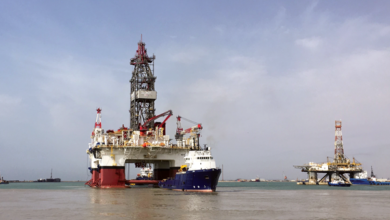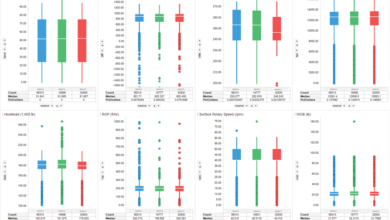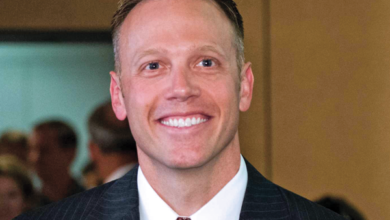Schlumberger Rig of the Future aims to optimize, integrate drilling subsystems to provide open and scalable well construction platform
New ways of working and skill sets will be required, with automation driving intelligent workflows connecting both the surface and subsurface systems
By Linda Hsieh, Managing Editor and Kelli Ainsworth, Editorial Coordinator

Justin Rounce is Senior Vice President of Marketing and Technology for Schlumberger.
Schlumberger is building what it has called the Rig of the Future. Can you tell us about it?
The Rig of the Future program is a natural extension of our Drilling Group strategy. When we formed the group several years ago, our strategy was to improve drilling efficiency, assure a high-quality wellbore and optimize well placement and the reservoir model.
Through that effort, we were able to bring together the major subsystems of drilling operations, such as the bit, fluid system and bottomhole assembly. Bringing those pieces together has demonstrated significant value in helping our customers lower finding and development costs per barrel.
However, when we looked at drilling as a whole, we realized that to make a material impact on well cost, we had to optimize the entire system, including the rig. The rig is a fundamental part of the operation, and we prefer to look at it as an integrated well construction platform.
When it comes to optimizing the rig, our focus is around mechanization and automation, as well as utilization of software and data. We are also looking at the fluid system, drill bit, downhole measurements and how the well is steered. The goal is not just optimizing all of those individual components but enhancing the overall integrated drilling system performance. Bringing those components together into an integrated system allows us to begin changing the process and optimizing workflows to improve performance and increase efficiency.
How far along are you in developing such an integrated system?
We’ve built and are currently testing two prototype rigs, which we are using to test and evaluate concepts and technology components as we develop them, including software applications.
The first generation of the fully mechanized “rig of the future” will be commercially available in the second half of 2017, along with specialized multiskilled crews. They will initially be used on our integrated project management projects, in which Schlumberger manages the well construction process on behalf of customers. This is a great way for us to deploy new technology more effectively and more expediently.

A couple of issues ago, DC reported on Schlumberger’s collaboration with Precision Drilling to optimize onshore directional drilling. Are you pursuing similar collaborations with drilling contractors for the Rig of the Future?
What we’ve done with Precision is a great example of how we would like to collaborate with the Rig of the Future program. As I said, we’re not thinking just about the rig but about an integrated well construction platform – some of the features and functionalities of this platform could be implemented to enhance the right type of rigs from other drilling contractors. We’re designing the system to be completely open, not a closed system that will only work with our rig.
Our software architecture allows us to bring other drilling contractors’ rigs into the program and still provide a level of integration and automation. It may not be as fully integrated as a Schlumberger rig, but it’s important to offer an open program. We want to continue working with companies like Precision and other drilling contractors that have the latest-generation land rigs.
We realize this solution isn’t “one size fits all.” That’s why we developed the system to be scalable, particularly on the software and data side. Through our Rig Power and Controls group, previously known as Omron Oilfield & Marine, we have the in-house project management and technical capability to execute these enhancements for various drilling contractors with these latest-generation rigs.
How will this type of integrated well construction platform change the roles of the people on the rig?
I think of this in two distinct parts – mechanization and automation. There are many good examples of mechanization on today’s rigs, but there are still many elements that have yet to be mechanized. Pipe handling on land rigs, for example, is one process that we want to fully mechanize. We don’t want anyone putting his or her hands on the pipe from the moment it goes onto the catwalk to the moment it goes into the hole. There are also other opportunities for mechanization, such as the fluid system and BOP handling.
With the relevant parts of the rig fully mechanized, we can start to bring in software automation. If mechanization is the physical brawn, then automation is the brain. Through automation, we start to add intelligence and connect the workflows. In fact, with automation, workflows can be redefined because we can think about doing things in a different way. We can start to connect a subsurface system in an intelligent way that drives the operation of the surface system.
Of course, by making the processes leaner, roles will be redefined. Rather than speaking of only the rig crew, we should be considering the optimization of the total well construction crew, including the service contractors who are involved in the well delivery process. Through a role-redefinition and multiskilling process, we estimate that we can cut back the total manhours to deliver a well by more than 30%. The rig crew will have to be comfortable with multiskilling, as well as the fact that the system will offer them more advice on what actions to take, especially in the drilling process.
The system will also accommodate changes. A plan is built before drilling is started, but during execution, the reality is always different from theory. The system has built-in intelligence that analyzes the impact of changes in the drilling process and will provide advice to the operators on the rig. As people become more comfortable with the system, the system won’t remain advisory anymore but can be trusted to take the action. This will require a very different skill set and mindset from our employees compared with the skills and mindset required 20 years ago.
Is it going to be so different that there’s not going to be a driller in the traditional sense anymore?
We think there’s always going to be a driller, but the actions the driller takes will evolve over time, and the support the driller gets will be fundamentally different compared with even 10 years ago. There’s a progression today of going from roustabout to roughneck to derrick operator to AD to night driller to day driller. I think that will change. In the future, people will go into their roles because they are trained for those roles, and they will have a lot more information available to them at all times. They will also have advisory services that may not necessarily be located on the rig.
Our project with Precision is a good example here, too. We’ve taken what used to be two directional drillers on the rig and moved one into an office. In the near future, we think there won’t need to be any directional drillers on the rig at all. We will have one directional driller working remotely and monitoring several operations at once.
Further, automation will change the way standards and procedures are enforced and followed. Right now, most companies still deliver them in paper format, but if there is a system that is software- and data-driven, then policies, procedures and work instructions can be programmed into the process so that the system understands what they are. That will start to drive compliance because it won’t let individuals do something that breaks one of the standards or policies. It also will help to drive performance, reduce risks and improve safety.
We’ve talked a lot about how to improve the drilling process. How can we do the same with completions?
For onshore unconventional completions, it’s really about efficiency. A lot of the technology developments are about how to deliver zonal isolation as efficiently as possible. We’ve moved beyond just 10 or 20 stages in a well to having hundreds of stages, and the amount of proppant we’re pumping is into the millions of pounds. One solution is the Schlumberger Infinity dissolvable plug-and-perf system that uses degradable fracturing balls and seats. We can isolate and stimulate a section, then drop a ball, then another and another, and they eventually dissolve. You don’t have to retrieve them.
On the other end of the spectrum are services such as the Manara production and reservoir management system, which we have deployed in the Middle East for Saudi Aramco. With that system, our focus is on maximizing the amount of contact with the reservoir. To do that, we would drill a main borehole and then drill additional wells off of that borehole. That created challenges in terms of how to control the production from a downhole perspective, as well as how to control what comes from each part of the well or each part of the reservoir. We’ll continue to drive these types of high-end intelligent completions to improve recovery.
Where do you see opportunities for more standardization in large and highly complex completions like what you did with the Manara system?
I’ll use the example of Formula One racing. If your car is less than 10 years old, there are components in your car that evolved from Formula One racing, like anti-lock brake systems. ABS brakes came from Formula One 20 years ago. Even the aerodynamics of cars today come from Formula One developments made in wind tunnels.
If Formula One is the top of the food chain when it comes to automotive technology, a technology like the Manara system is the top of the food chain when it comes to completion technology. Now we work similar to the car manufacturers: We take elements of that high-end system and apply them in a much more traditional and higher-volume way. Even before we commercialized the Manara system, we embedded elements of it into more compact and standard systems within our completions business. There’s always a drive to make high-end technology more compact and more available to a greater number of customers.
How can the industry install better and more reliable completions, particularly in subsea wells, to prevent costly workovers?
In subsea, you can’t discuss completions without talking about the subsea tree. There are two primary types of trees today – horizontal and vertical. One allows you to remove the tree without removing the completion, and the other doesn’t. Selecting the tree has always been a challenge for operators, and often the decision is driven by their confidence in the completion and in the tree. We need to continue to drive efficiency and reliability in completions, but we also need to innovate around the subsea tree.
There had not been any disruptive tree innovation for decades until 2015, when we introduced the HyFleX subsea tree system. It’s technically a horizontal tree in the sense that the tubing hanger is sitting in the top of the tree, but it’s configured into two modules. This design allows the operator to retrieve the main components of the tree that would typically be the cause of failure, without pulling the tubing hanger, and to pull the completion without removing the tree.
The HyFleX system also allows operators to drive efficiency through batch drilling. Normally, a well is drilled and completed, and the tree is installed. Now, the well can be drilled and completed without putting the main part of the tree on; just the lower part of the tree, the tubing head spool, is put on. This allows an operator to use a rig to drill wells one after the other and run the completion. Then, a much lighter-weight vessel is brought in to install the components of the upper part of the tree, connect all the umbilicals and do all the installation commissioning at a much lower cost.
Overall, I think the industry has done a fantastic job of moving toward standardized products. Standardization has driven an adoption of supplier standards and a move away from customization. When it comes to subsea completions, whether it’s the completion itself or the subsea infrastructure, customization drives up costs massively. If you can go with a standard completion type and a standard tree that requires no additional engineering upfront, then you can take significant costs out of subsea developments.
You’ve talked about a lot of technical innovations for our industry, but we know that technology acceptance and adoption is slow in our risk-averse industry. What changes can be made in the industry’s business model to pick up this pace?
Today, we have a very procurement-led process that is actually a challenge to innovation. Sequential procurement-type models are not conducive to supporting and driving innovation. The process has to change, but it’s incredibly ingrained into our industry. Change is especially difficult in a down cycle because people will gravitate to what they’re most comfortable with, which is driving down costs through the supply chain. At some point, we have to start talking more about value and how to align our values.
Schlumberger has been open about this, and we’ve stated publicly that we have to recover some of the pricing concessions that we’ve given to customers over the past 18 to 24 months. Current pricing will not be sustainable as the industry comes out of the bottom of this cycle. It’s hard to continue to invest in technology when you’re not getting the value associated with that investment. We’re starting to have very open conversations with our customers about this, and we’re very conscious about making sure everyone benefits from the results of those conversations. DC
Infinity, Manara and HyFleX are registered terms of Schlumberger.
Click here to read a case study on the Manara system’s deployment for Saudi Aramco.
Click here to view a case study for the Infinity dissolvable plug-and-perf system.




